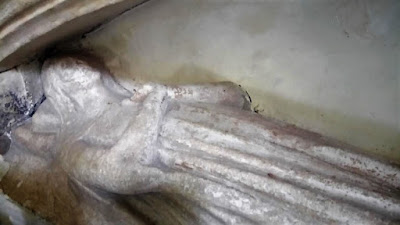'Oh no,' said my mother, 'I ache all over. And I need far more warning than that.'
'You wait,' said my friend as I downed a couple of cups of tea at her house over the road. 'By the time you go back, they'll have a list as long as your arm.'
And from that list, we decided upon Arlingham in Gloucestershire, where my Great Uncle Cecil and his family were evacuated during the war. My mother remembered travelling to visit her cousins on the back of his motorcycle.
Now there are some places that are special by virtue of their geography, and Arlingham is one of these, standing as it does almost at the tip of the tongue of land formed by a great swoop in the still tidal River Severn.
Although the land is part of the Severn flood plain and therefore very flat, you can tell by the light that you are almost encircled by water.
The one bench there was occupied so I settled the parents on some logs and went to have a closer look at the river.
Opposite is the village of Newnham in the Forest of Dean, with its church built high above the river in 1366 and one of the surprisingly large ships able to navigate this far upriver.
This was the site of a ferry crossing for at least 700 years.
It looks like you could easily wade across at low tide, and indeed, there's a rocky causeway that served for centuries as a fording place, but erosion in the 19th century caused the river to change channel.
We then drove back down the peninsula, stopping off at St Mary the Virgin in the neighbouring village of Frampton-on-Severn.
I settled my parents in a pew with a guidebook and set about seeing how many of the nine things you mustn't miss I could spot without reading the list.
The lead font dating from the 12th century, so reminiscent of the one from Lancaut in Gloucester Cathedral - that has to be on it, right?
Right!
The fact that Richard Madeley was priest here in 1375? (He really doesn't look that old, does he?)
Wrong!
OK. One solitary mediaeval floor tile in the north aisle, then?
Correct!
The Victorian funeral bier! Everyone loves a funeral bier!
Nope.
'Surely it can't be these,' sniffs Ted. 'There's not even a whiff of bones.'
Yes, the effigies of (possibly) members of the Clifford family, dating from (probably) the very early 14th century.
(The Knight had a box of matches tucked under his leg - presumably for when he gets tired of lying there and sneaks out for a woodbine.)
The fine Jacobean pulpit dating from 1622?
No, not special.
The painted organ pipes?
Positively mundane.
The fantastic south door with its sanctuary ring?
Yes - well, the ring, anyway. The door is common or garden, and only 800 years old.
Glass. There's some old glass at the very tops of the windows. Looks mediaeval.
Yes, but your pictures are a bit rubbish here, Harvey. Sort your camera situation out.
OK, struggling a bit now.
How about this stone dated 1558 to Henry Clifford and his wife, Mabel?
Try the porch.
 Look, weapon sharpening grooves on the bench from the 14th century.
Look, weapon sharpening grooves on the bench from the 14th century.Hmmm.
And high up on the tower, under the gargoyles - the mason, John Longstreth's mark, from 1734.
Can't see it, mate.
And the 15th century musicians and dancers under the gargoyles?
Have to take your word for it.
You've forgotten the piscina, back in the church?
Nah, sorry, bored now.





























No comments:
Post a Comment